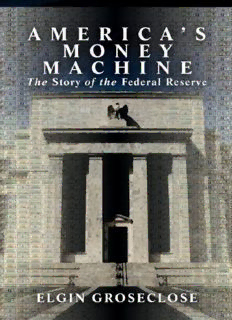
America's Money Machine: The Story of the Federal Reserve PDF
Preview America's Money Machine: The Story of the Federal Reserve
AMERICA’S MONEY MACHINE BOOKS BY ELGIN GROSECLOSE Money: The Human Conflict (1934) The Persian Journey of the Reverend Ashley Wishard and His Servant Fathi (1937) Ararat (1939, 1974, 1977) The Firedrake (1942) Introduction to Iran (1947) The Carmelite (1955) The Scimitar of Saladin (1956) Money and Man (1961, 1967, 1976) Fifty Years of Managed Money (1966) Post-War Near Eastern Monetary Standards (monograph, 1944) The Decay of Money (monograph, 1962) Money, Man and Morals (monograph, 1963) Silver as Money (monograph, 1965) The Silken Metal-Silver (monograph, 1975) The Kiowa (1978) Olympia (1980) AMERICA’S MONEY MACHINE The Story of the Federal Reserve Elgin Groseclose, Ph.D. Prepared under the sponsorship of the Institute for Monetary Research, Inc., Washington, D. C. Ellice McDonald, Jr., Chairman Arlington House Publishers Westport, Connecticut An earlier version of this book was published in 1966 by Books, Inc., under the title Fifty Years of Managed Money Copyright © 1966 and 1980 by Elgin Groseclose All rights reserved. No portion of this book may be reproduced without written permission from the publisher except by a reviewer who may quote brief passages in connection with a review. Library of Congress Cataloging in Publication Data Groseclose, Elgin Earl, 1899– America’s money machine. Published in 1966 under title: Fifty years of managed money, by Books, inc. Bibliography: P. Includes index. 1. United States. Board of Governors of the Federal Reserve System–History. I. Title. HG2563.G73 1980 332.1'1'0973 80-17482 ISBN 0-87000-487-5 Manufactured in the United States of America P 10987654321 For My Beloved Louise with especial appreciation for her editorial assistance and illuminating insights that gave substance to this work CONTENTS Preface Part I: The Roots of Reform 1. The Quality of the Times 2. The First Shock Wave 3. The Lapping at the Dikes 4. The Rich Man’s Panic 5. A Measure of Expediency 6. The Aldrich-Vreeland Bill 7. An Interlude for Debate 8. The Great Investigation 9. The Setting of the Current 10. The Bill Considered Part II: The Great Reversal 11. Advent of Storm 12. The First Inundation 13. Collapse of a Theory 14. The Path of Retreat 15. When to Reef Sail 16. The Wounds of War 17. Wading in the Big Pond 18. The Lapping Waves of Crisis 19. The Fulcrum and the Lever 20. The Gushing Fountain Part III: Debacle of an Idea 21. The Crumbling of the Dikes 22. The New Thermopylae 23. The Keynesian Influence 24. The Not So New New Deal 25. The New Deal and the Federal Reserve 26. New Bridles for Old 27. Where Two Tides Meet 28. The Reversals of War 29. Doubtful Victory 30. The Role of Atlas 31. The Not So Golden Years 32. The End of a Dream 33. The Chute 34. Into the Pit 35. Out of the Pit Notes Selected Bibliography About the Author Index Preface O N SEPTEMBER 30, 1913, at a moment when American attention was focused on the revolutionary monetary reform then under debate in Congress, the New York Times astounded and diverted its public by a bitter attack on a former president of the United States. The former president was Theodore Roosevelt who had, the year before, broken away from the Republican Party to run as the Progressive Party (Bull Moose) candidate for president. He had been defeated by Woodrow Wilson, but he had been a powerful candidate who had attracted the greater part of Republican Party votes, and his views on public questions still commanded a large following among the electorate. What had aroused the mortal apprehensions of the Times’ editors was an article in the Century Magazine in which Roosevelt had outlined his proposals for a reorganization of government and society. The editorial attacked his blueprint as “super-socialism.” Without going so far as to charge Roosevelt with being a Marxist—this was before the Russian Revolution, but Marxism was even then anathema on these shores—it declared that he would in effect bring a Marxian redistribution of wealth in a “simpler and easier way.” “He leaves,” the editorial went on to say, “the mines, the factories, the railroads, the banks—all the instruments of production and exchange—in the hands of their individual owners, but of the profits of their operations he takes whatever share the people at any given time may choose to appropriate to the common use. The people are going to say, We care not who owns and milks the cow, so long as we get our fill of the milk and cream. Marx left socialism in its infancy, a doctrine that stumbled and sprawled under the weight of its own inconsistencies. Mr. Roosevelt’s doctrine is of no such complexity. It has all the simplicity of theft and much of its impudence. The means employed are admirably adapted to the end sought, and if the system can be made to work at
Description: